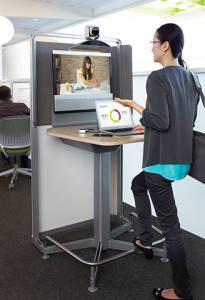British business facing a challenge to break through the distance barrier
London, April, 2015 – Making distance disappear is fast becoming a major challenge for businesses operating across multiple locations.
Despite advances in technology, office workers are still complaining about dysfunctional technology when trying with work colleagues based el sewhere.
sewhere.
Recent research from Steelcase, the world leader in the provision of high performance workplace solutions, found that one of the consistently troubling problems distributed teams face is presence disparity.
Bostjan Ljubic, vice president Steelcase UK and Ireland said: “We all know what it is like to be physically present at a meeting. But when we work remotely we don’t have the same experience as the people who are in the room together. Not only is the experience different when we are remote, sometimes it is just plain bad. Presence disparity is more than just an annoyance, as it can undermine the benefits of having a diverse, distributed team as well as hurt productivity.”
Steelcase research shows:
- 71 % have experienced one or more problems when working remotely
- 29% of workers who regularly use phone and video conferencing say they have intentionally or unintentionally left out a colleague
- 56% report at least one or more of these distractions
When the reality of presence disparity isn’t addressed, the overall collaboration experience can easily become unpleasant and taxing, with participants feeling strained physically, cognitively and emotionally. Meanwhile, as the pace of work has intensified, people often find themselves in a “mixed presence” work mode – they are physically present in one conversation, while being virtually present in another often texting, emailing and posting etc. Distractions abound, workflow gets bottlenecked and misunderstandings, misinterpretations and conflicts escalate. As chaos and frustration ensue, progress slows or gets totally derailed.
Steelcase reveals that although many organisations offer videoconferencing at boardroom level, they don’t realise the need to design spaces and video experiences that are easy to use, available to a wider range of staff and which successfully recreate the experience of being together.
Conference rooms are the most used spaces for videoconferencing, yet typical conference rooms with long rectangular tables can be difficult for face-to-face meetings and are not ideal for video conferencing. People are locked into seated postures at a long table, which makes it impossible to have everyone on camera. And, because of the camera angle and limited floor space, anytime someone stands or walks around it’s disruptive. These different forms of collaborating require different working environments that integrate video into a seamless experience.
Bostjan Ljubic, continues: “Businesses need to offer workers a level of technology that the smart phone generation has become used to but in a corporate setting.
“Steelcase research and designers have partners in order to create collaboration destinations. These spaces have been designed for distance collaboration and to support workers before, during and after a collaboration session. They also allow people to assemble information, change posture and see participants eye-to-eye, as well as taking lightning, camera and microphone placement into consideration. “
Understanding the tension of being a distributed team leads to an understanding of the design opportunities. Among the insights derived from Steelcase’s research into distribution teams are six concepts for consideration:
- Consider camera and microphone placements carefully. Develop a layout that allows all users to be on camera and clearly audible. Include multiple screens so participants can see each other and their content at the same time, making sure people can move and stay on –camera without disrupting the flow of interaction.
- Create zones that allow people to move fluidly between group work and privacy. People in collaborative teams make quick switches between these modes throughout the day. Glass walls in the room can create acoustical separation while supporting continued visual access.
- Designing the environment to encourage movement and a range of postures so that participants can stay energised and engaged.
- Think about both sides of the experience. Provide similar environments in all locations, equipment with the same level of tools and technology controls.
- Consider how the space can help build trust. For instance, just outside the team room – a continuously open real-time video connection that acts like an open window between two locations – can help promote social exchange as people come and go.
- Plan for a range of team sizes and videoconference exchange. One-on-one interactions, paired work and collaboration among subset are as important as full time session. Distribute as many choices as possible – videoconference kiosks adjencent to the team space, nooks within it and even mobile solutions – to leverage real estate and encourage use of the technology.
